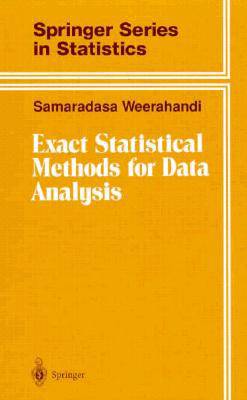
- Retrait gratuit dans votre magasin Club
- 7.000.000 titres dans notre catalogue
- Payer en toute sécurité
- Toujours un magasin près de chez vous
- Retrait gratuit dans votre magasin Club
- 7.000.0000 titres dans notre catalogue
- Payer en toute sécurité
- Toujours un magasin près de chez vous
Exact Statistical Methods for Data Analysis
Bell Weerahandi, Sam Weerhandi, Samaradasa Weerahandi, S Weerahandi
151,45 €
+ 302 points
Description
1 Preliminary Notions.- 1.1 Introduction.- 1.2 Sufficiency.- 1.3 Complete Sufficient Statistics.- 1.4 Exponential Families of Distributions.- 1.5 Invariance.- 1.6 Maximum Likelihood Estimation.- 1.7 Unbiased Estimation.- 1.8 Least Squares Estimation.- 1.9 Interval Estimation.- Exercises.- 2 Notions in significance testing of hypotheses.- 2.1 Introduction.- 2.2 Test Statistics and Test Variables.- 2.3 Definition of p-Value.- 2.4 Generalized Likelihood Ratio Method.- 2.5 Invariance in Significance Testing.- 2.6 Unbiasedness and Similarity.- 2.7 Interval Estimation and Fixed-Level Testing.- Exercises.- 3 Review of Special Distributions.- 3.1 Poisson and Binomial Distributions.- 3.2 Point Estimation and Interval Estimation.- 3.3 Significance Testing of Parameters.- 3.4 Bayesian Inference.- 3.5 The Normal Distribution.- 3.6 Inferences About the Mean.- 3.7 Inferences About the Variance.- 3.8 Quantiles of a Normal Distribution.- 3.9 Conjugate Prior and Posterior Distributions.- 3.10 Bayesian Inference About the Mean and the Variance.- Exercises.- 4 Exact Nonparametric Methods.- 4.1 Introduction.- 4.2 The Sign Test.- 4.3 The Signed Rank Test and the Permutation Test.- 4.4 The Rank Sum Test and Allied Tests.- 4.5 Comparing k Populations.- 4.6 Contingency Tables.- 4.7 Testing the Independence of Criteria of Classification.- 4.8 Testing the Homogeneity of Populations.- Exercises.- 5 Generalized p-Values.- 5.1 Introduction.- 5.2 Generalized Test Variables.- 5.3 Definition of Generalized p-Values.- 5.4 Frequency Interpretations and Generalized Fixed-Level Tests.- 5.5 Invariance.- 5.6 Comparing the Means of Two Exponential Distributions.- 5.7 Unbiasedness and Similarity.- 5.7 Comparing the Means of an Exponential Distribution and a Normal Distribution.- Exercises.- 6 Generalized Confidence Intervals.- 6.1 Introduction.- 6.2 Generalized Definitions.- 6.3 Frequency Interpretations and Repeated Sampling Properties.- 6.4 Invariance in Interval Estimation.- 6.5 Interval Estimation of the Difference Between Two Exponential Means.- 6.6 Similarity in Interval Estimation.- 6.7 Generalized Confidence Intervals Based on p-Values.- 6.8 Resolving an Undesirable Feature of Confidence Intervals.- 6.9 Bayesian and Conditional Confidence Intervals.- Exercises.- 7 Comparing Two Normal Populations.- 7.1 Introduction.- 7.2 Comparing the Means when the Variances are Equal.- 7.3 Solving the Behrens-Fisher Problem.- 7.4 Inferences About the Ratio of Two Variances.- 7.5 Inferences About the Difference in Two Variances.- 7.6 Bayesian Inference.- 7.7 Inferences About the Reliability Parameter.- 7.8 The Case of Known Stress Distribution.- Exercises.- 8 Analysis of Variance.- 8.1 Introduction.- 8.2 One-way Layout.- 8.3 Testing the Equality of Means.- 8.4 ANOVA with Unequal Error Variances.- 8.5 Multiple Comparisons.- 8.6 Testing the Equality of Variances.- 8.7 Two-way ANOVA without Replications.- 8.8 ANOVA in a Balanced Two-way Layout with Replications.- 8.9 Two-way ANOVA under Heteroscedasticity.- Exercises.- 9 Mixed Models.- 9.1 Introduction.- 9.2 One-way Layout.- 9.3 Testing Variance Components.- 9.4 Confidence Intervals.- 9.5 Two-way Layout.- 9.6 Comparing Variance Components.- Exercises.- 10 Regression.- 10.1 Introduction.- 10.2 Simple Linear Regression Model.- 10.3. Inferences about Parameters of the Simple Regression Model.- 10.3 Multiple Linear Regression.- 10.4 Distributions of Estimators and Significance Tests.- 10.5 Comparing Two Regressions with Equal Variances.- 10.6 Comparing Regressions without Common Parameters.- 10.7 Comparison of Two General Models.- Exercises.- Appendix A.- Elements of Bayesian Inference.- A.1 Introduction.- A.2 The Prior Distribution.- A.3 The Posterior Distribution.- A.4 Bayes Estimators.- A.5 Bayesian Interval Estimation.- A.6 Bayesian Hypothesis Testing.- Appendix B Technical Arguments.- References.
Spécifications
Parties prenantes
- Auteur(s) :
- Editeur:
Contenu
- Nombre de pages :
- 344
- Langue:
- Anglais
- Collection :
Caractéristiques
- EAN:
- 9780387943602
- Date de parution :
- 17-10-03
- Format:
- Livre relié
- Format numérique:
- Genaaid
- Dimensions :
- 163 mm x 242 mm
- Poids :
- 639 g

Les avis
Nous publions uniquement les avis qui respectent les conditions requises. Consultez nos conditions pour les avis.






